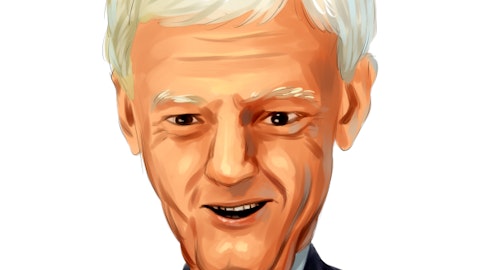Betsy Graseck: Okay, one follow-up question on NII and then a question on expenses. Just a follow-up question on NII Eric, I just wanted to make sure I understood the cadence, the pace that you are suggesting NII should follow. I know you used the word attenuate, but we had a debate over here as to which way attenuate was going to traject, so sorry to ask the ticky-tacky, but appreciate it?
Eric Aboaf: That’s all right. But we want to be transparent and sometimes language always matters, as you say. Our perspective is we’ve got a very nice step-off point from fourth quarter NII. We said we’d be roughly flattish into the first quarter. And then we expect it to trend downwards, so attenuate downward, let’s say, 1% to 2% for the next few quarters. Just as you see you see a tailwind of interest rates creating a positive but you see that continued rotation out of net interest bearing deposits being a headwind. And the net of that is down NII we think 1% to 2% for a couple of quarters. And then towards the end of the year and into 2024, we see rough stabilization probably because we’ve kind of burned out on the noninterest-bearing rotation, and then we get to a more stabilized area. But all in, we expect full year NII to be up about 20% year-over-year, and we’ll take it from there.
Betsy Graseck: Got it. Yes. No, that’s helpful. And then on the expense side, I know you mentioned that the benefit of the actions you’ve taken, am I right, $100 million run rate. I just wanted to understand when that comes into the 2023, is that immediate in 1Q, or is that something that comes in over time, just that would be helpful? Thanks.
Eric Aboaf: Yes. Roughly about half of that comes in, in 2023. The payback on most of these actions is about five quarters so roughly half comes in on a fiscal 2023 basis. And then we’ll hit the run rate, I think, within quarters, whatever, sixish or something after these actions, most of these actions are in the next few let’s call it the next quarter. The run rate then builds to $100 million. So good payback and the kind of actions we want to keep taking in this kind of environment.
Betsy Graseck: Yes. So your point, that was my final follow-up, which was, do you feel this is the extent or if for whatever reason, top line disappoints based on macro not working out or what have you, is there more that you would consider doing going forward?
Ronald P. O’Hanley: Betsy, it’s Ron. Maybe I’ll take that. I mean, we’ve obviously got a pattern of investments that we’re intending to execute. We’ve also got an ongoing program in place that we’ve really had running now since 2019. So we certainly — if the environment were to change materially, we would think about those investments. We would also think about being more aggressive. I mean, we have more or less in the background, continued to take a lot of gross expense out of the system every year. We see an ongoing ability to do that, but we also want to keep investing in the business. So there is a balance there. But to the extent to which things started to go south in an unanticipated way, I mean we do have levers.
Betsy Graseck: Thank you.
Operator: Thank you. Your next question comes from the line of Ken Usdin from Jefferies. Please go ahead.
Kenneth Usdin: Thanks, good morning. I was wondering if we — if you had any kind of just — well, post-game thoughts — post the BBH decision and within that, just you acknowledged and put forth this $4.5 billion capital plan. Just how will we think about just your commitment to that now as opposed to whatever thoughts you might have about acquisitions going forward? Thank you.
Ronald P. O’Hanley: Ken, I mean, as we’ve always said, we’ve got a very clear strategy and M&A is not a strategy. M&A is a way to help execute a strategy, to move it faster, to enable it to get further than was anticipated. But it’s not a strategy by itself. We are very comfortable with our organic strategy. BBH was a scale enhancing acquisition that we would have liked to have done, but it doesn’t materially change. In fact, it doesn’t change at all our strategy. So at this point, where we sit, we have a strategy that we like. We have a strategy that we’re executing against. There are some big milestones that we’re confident we’re going to be delivering on in 2023. And therefore, we are committed to that share buyback.
Kenneth Usdin: Okay, great. And then on servicing fees, can you help us understand in your flat to plus one, what’s the impact of the BlackRock ETF deconversion, where are we in that process, and how much, if any, has already been recognized of that expected revenue attrition at this point? Thank you.
Eric Aboaf: Yes, I think maybe just to answer that in the various components. I think you saw the BlackRock transition begin at the end of last year was $10 million in the quarter, sort of call it, a $40 million run rate. That continues to transition out in 2023 and in 2024, there’s obviously just a natural schedule that you expect that we’ve worked closely with them on. And so it’ll impact our servicing fees during 2023, during 2024, and into 2025, just when you think about the year-on-year comparison basis. I think if you want to model it out broadly, we’ve said in our last regulatory filing, we said it was worth about two percentage of fees as of the December 31 pointer we just crossed. It’s now about 1.7% of fees. And I’ll let you sort of build it from there.
But it’s included in our forecast. It will continue to be included in our forecast. We think about net new business, right, we’ve got to sell. We always have a bit of attrition, and we’ll — we want to continue to be net ahead. And as you’ve seen us in the last couple of years, we’ve been net positive with net organic growth broadly. And then with BlackRock, specifically, they continue to be a very important client of ours. We have continued and kept a good amount of business that we do with them. We’re strong providers for them in alternatives, which is growing quickly. And we’ve also been awarded new business over the last year. And so that will just — I think it will just be part of the outlook that I give you as we go forward.
Kenneth Usdin: Okay, great, thanks a lot.
Operator: Thank you. Your next question comes from the line of Alex Blostein from Goldman Sachs. Please go ahead.
Alexander Blostein: Hi, good morning. Thanks for the question. Maybe just to follow-up on Ken’s last point around servicing fees. I guess if you take your run rate servicing fees at the end of the year, it still implies a pretty wide gap versus where you guys expect to end for 2023. So maybe just provide a little bit more granularity where the ramp is going to come from. So I know equity market is one thing, and you guys are assuming, I think, 10-ish-percent growth in global equity, so that certainly helps. But off of the kind of $4.8-ish billion run rate that you exited that to get to, I don’t know, $5.1 billion, that’s a 6% growth that’s still wider than we’ve seen in the past. So I’m just curious whether it’s new business or something else that you see on the horizon that will help you bridge that gap?
Eric Aboaf: Yes. Alex, if you — I think I tend to spend a little more time on the full year to full year kind of servicing fees, it sounds like you’re modeling the last four quarters and then the next four quarters, which obviously model as well, and we have in our budget. It’s really a combination of factors, right. So there is — on a — if you start with fourth quarter of 2022 and then work forward, we expect some appreciation in equity markets. We’ll see if that plays out, and we’ll obviously stay in touch with you all. We think that will be a tailwind. We think client flows and activity, in particular, should not be a headwind like it was in 2022, maybe neutral, maybe a positive just as clients have adapted to this new environment.
And so we see the new year — this new year as a time when they’re going to be trading, investing, building positions. So we’ll see if that plays out, that will be part of it. Then we have net new business. And so we do have a good pipeline both in the traditional servicing and Alpha area. And I think as part of that, we continue to mine our existing client base because the share of wallet growth can be positive there. And then finally, there’s always some amount of normal pricing headwinds, but that’s factored in. But you kind of have to go through those four areas. And remember, we’re assuming some growth in equity markets on a point-to-point basis but we’ll see if that plays out.
Alexander Blostein: I got you. Alright, that’s helpful. Maybe just a follow-up around the balance sheet strategy. I heard the NII guidance, the deposit commentary all makes sense. When it comes to the tailwinds from sort of repricing the fixed portfolio, the fixed securities portfolio, can you help us frame what the roll-on, roll-off dynamic looks like today? And also whether or not there are some more opportunistic actions you guys might take liqutine with both RFBK and Northern over the last month or so. With respect to just maybe reaccelerate some of the lower-yielding securities roll off into something that might be a little more attractive here.





